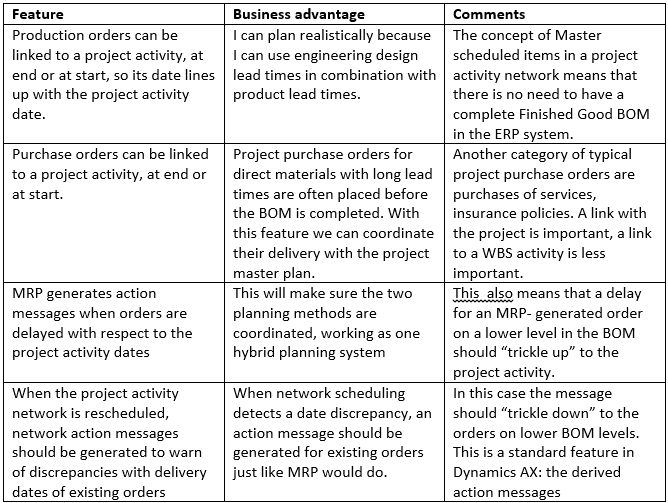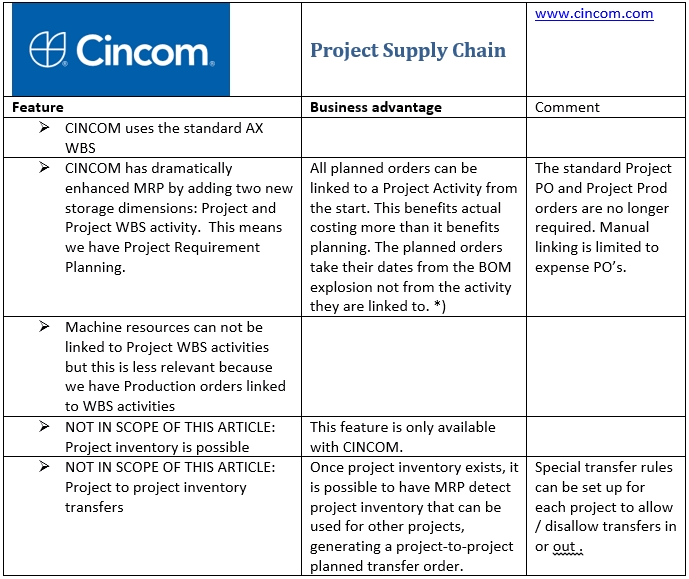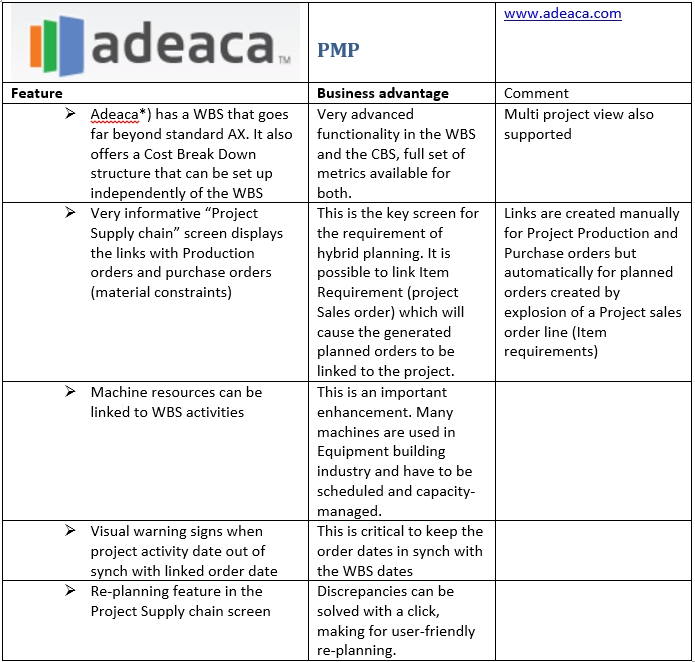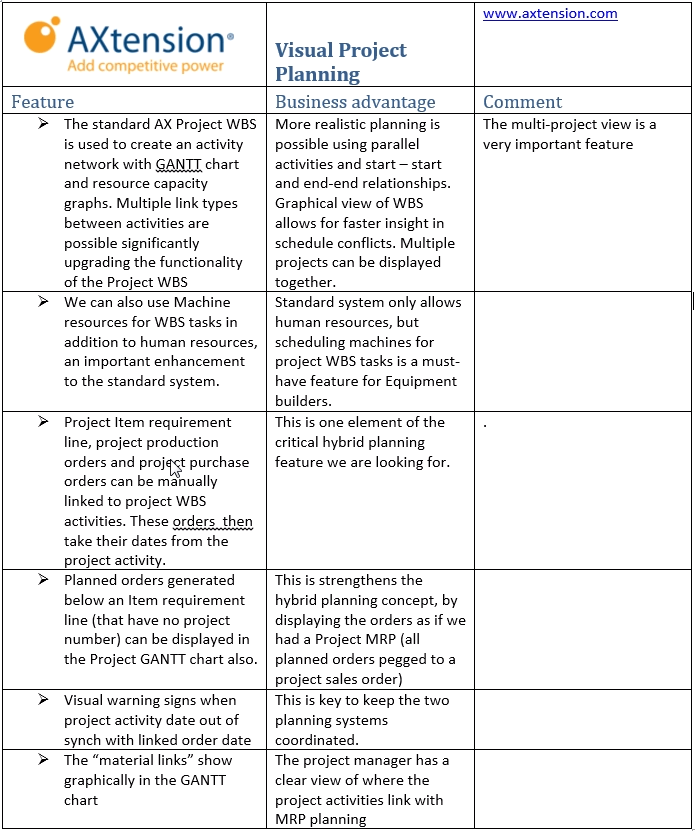Equipment builders need to plan and schedule their order fulfillment like every other manufacturing business. The difference is that this industry, being Make-to-Order/Engineer-to-Order, has a lot more to worry about then just shipping a product. The customer delivers specifications that have to be analyzed, engineer’s need to be consulted, new materials and new vendors may need to be sourced, design drawings have to be created, new part numbers, BOM’s and routings have to be added to the ERP system. Typically, all of these moving parts are planned in a project management tool such as Microsoft Project or similar. At the same time, the created Bills of Material have to be executed to schedule the hundreds of production and purchase orders using product lead times, which is what MRP will do. These are two planning methods that are completely different. One plans activities, the other plans materials. Equipment builders need both. Can these two planning system be connected? Can we find a hybrid planning system that handles both?
Since ERP systems have caught up with the ETO industry, there is always a project module in an ERP system and Dynamics AX is no exception. The project module has grown to offer quite a bit of functionality in the last 4 years. It does not have the hybrid planning feature described above, but there are third party add-ons that do. These solutions all enhance the Dynamics AX project module.
The planning vision
What would a hybrid planning system that combines traditional MRP with a project management tool look like? There are two fundamental features we would expect:
- MRP can be run for a project, this means that planned orders would have a project number but also a link to a specific work breakdown structure activity within the project.
- When such links exist, MRP takes its due dates from project activities start or end dates.
The hybrid planning concept assumes that the major milestone dates in the project work breakdown structure drive the due dates for major assemblies. The orders for these so called “master scheduled items” would be linked to the project activities within the work breakdown structure. On lower BOM levels, traditional MRP BOM takes over and schedules the orders. Exceptions would be individual purchase orders for long lead time items that are linked to a project activity. Because the BOM is not finished for quite some time, and we already need some materials for prototyping, we can order these directly, linking purchase orders to the start of activities related to prototyping. The image below shows the hybrid planning concept.
 A simplified project work breakdown structure is shown graphically as a series of project activities. The ability to link a production order to a project activity is the critical feature that allows for hybrid planning that fits the business of IEM project manufacturing companies. Major assemblies should get their delivery date from the project activity network, MRP BOM explosion will then calculate all dates for the orders on BOM levels below. We can call the items whose production orders are directly linked to the activity network: “Master Scheduled items”.
A simplified project work breakdown structure is shown graphically as a series of project activities. The ability to link a production order to a project activity is the critical feature that allows for hybrid planning that fits the business of IEM project manufacturing companies. Major assemblies should get their delivery date from the project activity network, MRP BOM explosion will then calculate all dates for the orders on BOM levels below. We can call the items whose production orders are directly linked to the activity network: “Master Scheduled items”.
A project activity network contains milestones and a critical path, it describes the design activities, customer site visits, and many other activities that may be necessary and have to be planned before we even start one manufacturing activity. The WBS-MRP links are critical to make sure that the entire project supply chain remains in synch with the project overall plan.
For many years, this problem remained unresolved in ERP systems. Equipment manufacturers often used Microsoft Project for project planning, and an ERP system to manage the production and purchase of materials, where both systems are kept in synch manually. But things have improved. While the standard system does not have the hybrid planning feature, three third party software enhancements for Dynamics AX are coming very close. We will evaluate each of them against our desired hybrid vision.
Before we start reviewing the third party software solutions, a more detailed description of our desired hybrid planning functionality follows below:
Features of a hybrid planning system

THIRD PARTY SOLUTIONS THAT ENHANCE DYNAMICS AX PROJECTS
Three third party software solutions that enhance standard AX project functionality are:
1. CINCOM Project Supply Chain
2. AXTENSION Visual Project Planning
3. ADEACA PMP
A brief review of each follows below, focusing exclusively in this aspect of hybrid planning. Much more functionality is offered in these systems, which will be reviewed later.
SIKICH EVALUATION OF CINCOM
CINCOM has added a lot of functionality that enhances project costing significantly but not so much planning and scheduling. Because of the introduction of the project dimension it has all the potential to fully realize our hybrid planning vision in a future release.


SIKICH EVALUATION OF ADEACA
A fair comparison is not possible here as ADEACA is in a different league (also price) offering a very complete project solution. ADEACA is certified by the Project Management Institute. But as far as the hybrid planning features, which is our only focus in this article, ADEACA offers identical functionality as AXTENSION, with an easy way to resolve date conflicts or discrepancies in the project schedule.
SIKICH EVALUATION OF AXTENSION
Sikich considers AXTENSION an excellent step towards the hybrid planning goal. It elegantly realizes one of the two key requirements: MRP can take demand dates from the project activities. We also give high praise to the option to link machine resources to project activities.
However, AXTENSION has not touched the MRP functionality itself but uses pegging to include planned orders in the display that are not directly linked to any project, but pegged to a project sales order.






